With more than 30 species of fish recorded in the Wye, it is one of the most important river systems in Northern Europe, having internationally significant populations of salmon, Twaite Shad and bullhead, as well as three species of lamprey. Migrating fish like the Twaite Shad come into the National Landscape to spawn, whilst salmon move through on the way to their spawning areas upstream. Except for salmon most fish still maintain healthy populations in the high quality environment of the river Wye and its tributaries.
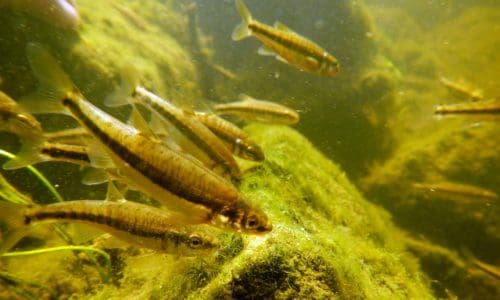

Photo: Salmon, Wye and Usk Foundation
In the past the Wye was famed for its salmon, which swim thousands of miles across the Atlantic to spawn in the Wye. They make nests (called redds) in the gravel to lay their eggs and the males defend their territory. Small young male salmon are called ‘parr’ and they live in freshwater for up to six years before changing into ‘smolts’. They swim downstream to the sea in spring. Morphological changes allow them to survive in saltwater. Sadly pollution of the Wye has led to a significant decline in salmon numbers.
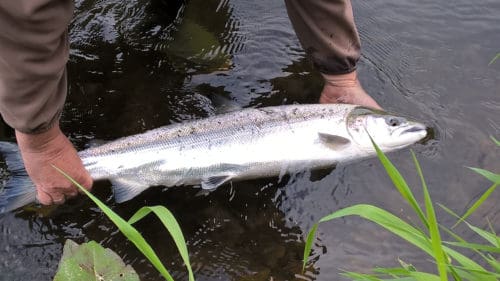

Photo: Salmon, Wye and Usk Foundation
The Wye was once considered to be one of the finest salmon rivers in the country and at its peak, rod catches of salmon exceeded 7,000 a year. Robert Pashley, who fished near Goodrich Court, was the most successful salmon fisherman in the history of the river Wye. Between 1906 and 1951 he caught over 10,000 salmon, with his best year in 1936 when he caught 678 salmon! The salmon’s decline in the Wye has been dramatic. In 2010 rod catches for the whole river were a mere 451. Today the Wye and Usk Foundation works to conserve, protect, rehabilitate and improve the salmon and other indigenous species of animal and plant life of the rivers Wye and Usk and their tributaries. You can find out about their work here https://www.wyeuskfoundation.org/
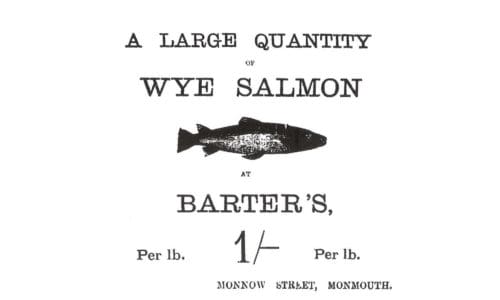

Photo: Chepstow Museum
Stop netting was a traditional method of salmon fishing on the tidal sections of the Wye. It involved the use of stop nets – two long poles some 18 feet long fixed together like a pair of compasses with a net shaped like a purse fastened between them. The stop net season ran from April to August and was commonly seen on the lower sections of the Wye from Brockweir downstream.
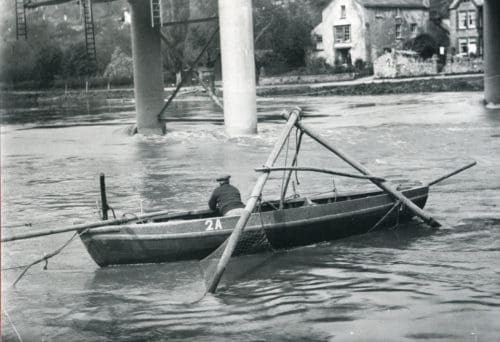

Photo: Chepstow Museum
The river contains brown trout and many coarse fish species including stone loach, dace, roach, eel, grayling, gudgeon, minnow, carp, three-spined stickleback and rudd. It is one of the UK’s top rivers for barbel and also has good stocks of large chub, silverfish and pike. Flounder inhabit the lower reaches, particularly the tidal parts of the river and have occasionally been recorded further upstream. A very rare visitor to the Wye is the sturgeon, which hasn’t been recorded since the 19th century. A massive sturgeon 2.2.m long and weighing 182lb was caught at Hereford in 1846, the remains of which are on display in Hereford Museum.
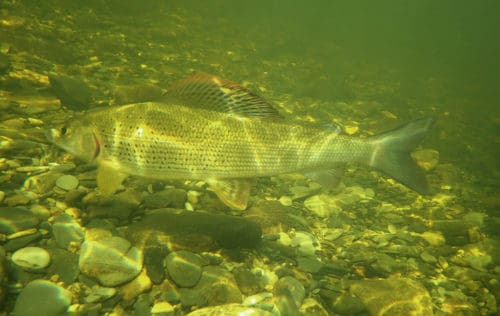

Photo: Grayling, Wye and Usk Foundation
The Twaite Shad is a species of herring living most of their life in coastal waters but migrating into rivers in May, giving them the name ‘May fish’. The Wye is one of only four rivers in Britain the Shad migrate to spawn in and it contains the largest spawning population in the UK. In the past they were caught in large quantities along the Wye, using a special net called a cleach net. It looked like an immense landing net on the end of an 18 foot larch pole. The river needed to be running high so the fishermen could stand on the bank and scoop up the fish as they swam upstream. Many fishermen thought that Shad were inedible due to the number of small bones they have. They were mainly caught for their roe. The rest was given to the pigs!
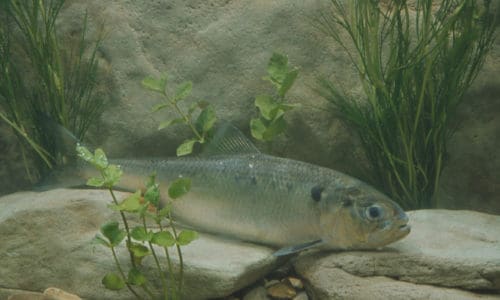

Photo: Shad, Environment Agency
Three species of lamprey are found in the Wye – river, brook and sea. These prehistoric looking creatures are some of the most primitive vertebrates alive today. They are known as cyclostomes, which means ’round mouths’ refering to the fact that they are jawless, having a round sucker-like mouth. A further primitive characteristic is that the skeleton consists of cartilage and not bone. Lampreys are similar in shape to eels, and have a series of uncovered round gill openings (known as gill pores) on the sides of the head. The river lamprey can be distinguished from other lampreys as it has two separate dorsal (back) fins, and just a few teeth around the mouth. It is bluish grey or green on the back and sides and the underside is white. Sea Lampreys, up to four feet long, migrate to the Wye in May and June to spawn, moving rocks on the river floor with their sucker-like mouth to make a nest. This amazing video by John Waters for the Wye and Usk Foundation, shows Sea Lampreys spawning. https://www.wyeuskfoundation.org/video-with-banner
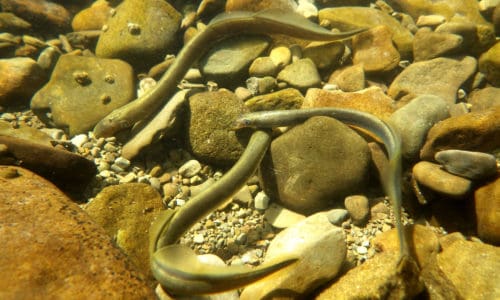

Photo: Brook lamprey, Wye and Usk Foundation
The end of an extraordinary 2,500 mile journey ends every April in Llandogo. Elvers (baby eels) start life in the Sargasso Sea (near Bermuda), where the eggs hatch into transparent eel larvae which drift across the Atlantic on ocean currents, a journey which takes three years. By this time they have grown into little glass eels and find their way into the river Wye, swimming upstream with the incoming spring tides. Eels like slow moving, silty environments where they can bury themselves in the mud at the bottom of the river. They like to stay there during the day and come out to feed at night, so if you want to see one that’s the best time to be looking. They remain in the river for about seven years, before a return journey is made back to the Gulf, to spawn and die.
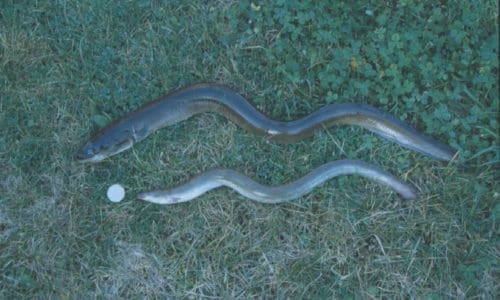

Photo: Eels, Environment Agency
It is said that the best elvers in the world were caught in Llandogo. For centuries, local fishermen with large nets waited on the riverbank to scoop the slithering mass of elvers from the water. Once caught the elvers were made into a ‘cheese’, by pressing all the slime and water out, washing them and cooking before another pressing through a fine muslin to form a ‘cheese’. These slices of ‘cheese’ were then fried in bacon fat! Over the last 50 years elvering has changed from being an annual village tradition, to a commercial operation undertaken by outsiders who exported the elvers to Japan where they are an expensive delicacy. Overfishing has devastated the elver population and the fishermen’s tilly lamps flashing along the riverbank are now only a memory. The Wye and Severn are one of the biggest elver fisheries in Europe. Here’s a fascinating film about the conservation work the Severn and Wye Smokery are doing to save the eel.
These are the UK’s only native freshwater crayfish and the River Wye system is the best site known in Wales for them. Crayfish are naturally found amongst stones in the river bed and bank, and amongst tree roots and in other cavities such as stone walls. They favour clean water habitats and are therefore sensitive to pollution. Their survival has been threatened by the introduction of the North American signal crayfish. This non-native crayfish competes for food and habitat, and carries the crayfish plague. This fungal plague is also carried in water and on equipment such as wetsuits, canoes and fishing equipment that have been in contact with infected water or crayfish. For this reason it’s really important that you make sure all equipment is dried thoroughly to kill the infection before you use it again.
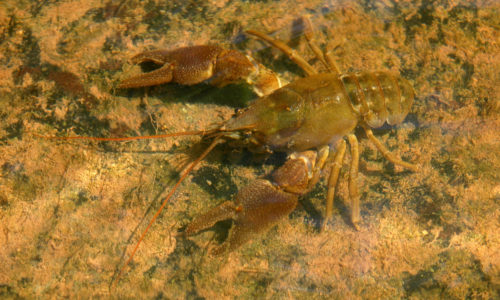

Photo: White clawed crayfish, Wye and Usk Foundation
You need a valid rod licence if you are aged 13 or over and fish for salmon, trout, freshwater fish, smelt or eel in Wales and England. This applies to all waters, whether they are owned by angling clubs, local authorities or private individuals. You must always carry your rod licence when you’re fishing or you could be prosecuted and fined up to £2,500. You can buy your licence online or at your local Post Office or over the phone by calling the Environment Agency on 0344 800 5386.
Run by the Wye and Usk Foundation, this is one of the biggest day ticket schemes in the UK offering anglers direct access to over 200 river and still water fisheries across Wales and the Marches. The Fishing Passport is a quick, easy way of booking day tickets and also gives information on latest catches, river conditions, instructor/guides and where to stay.
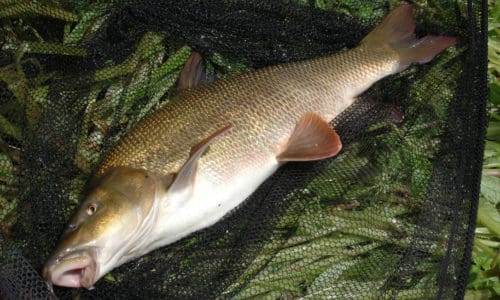

Photo: Barbel, Wye and Usk Foundation
The Club has 5 miles of fishing on the River Wye with 30 named pools on the estate of the Duchy of Cornwall both above and below Ross on Wye. Their waters are situated between Backney beat upstream and Goodrich Court downstream, including much of the water fished by Robert Pashley, the most successful salmon fisherman in the history of the river Wye who caught over 10,000 salmon!
The Society has fishing on three lakes and three rivers including the Hadnock stretch of the River Wye at Monmouth, referred to as the “Upper” beat. Members can fish for specimen chub and barbel on the River Wye and winter grayling. Fishing is not allowed during the salmon season (currently 3rd March to 17th October). Day memberships can be purchased by non-members and visitors.